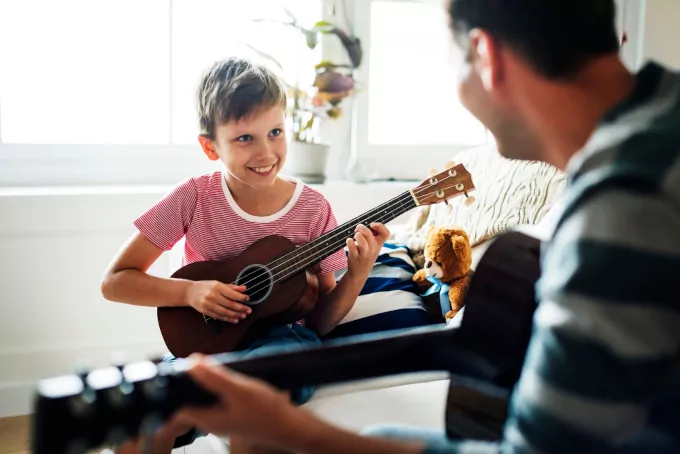Learning to play the guitar, especially for children, is a pleasant and enriching experience. Music has a significant impact on a child’s cognitive, emotional, and social development, and the guitar, due to its variety and accessibility, can be a great instrument for children to explore their musical potential. In this post, we’ll look at how youngsters learn to play the guitar, its benefits, and practical tactics for a successful and pleasurable musical journey.
The first step in training children to play the guitar is to pique their interest and enthusiasm for the instrument. Introducing youngsters to various music types and guitar-playing skills might assist them in discovering what resonates with them. Please encourage them to listen to music from all genres and see performances by their favorite guitarists. This exposure can arouse curiosity and excitement, providing the groundwork for a lifelong interest in guitar playing.
Choosing the right guitar for your child is critical to ensuring a great learning experience. Starting with a smaller or half-sized guitar is recommended for young children because it will be easier for them to carry and play. Acoustic guitars with nylon strings are easier on the little fingers and are therefore perfect for beginners. As children’s skills develop, they can advance to full-sized or electric guitars, depending on their interests.
It is critical to provide a fun and engaging learning environment for children for they to remain motivated and excited about practicing the guitar. Use colorful and dynamic instructional tools such as music games, flashcards, and age-appropriate songbooks to make learning more pleasurable. To keep the youngsters interested in their guitar lessons, incorporate enjoyable activities such as musical games, jam sessions, and duets with the teacher or other students.
Patience and encouragement are essential when training children to play the guitar. It may take some time for children to develop their motor skills and finger coordination, therefore it is critical to be patient and encouraging throughout the learning process. Teachers should emphasize positive reinforcement and recognize modest accomplishments to promote a sense of accomplishment and confidence in students.
Learn to Play the Guitar
It is critical to provide structured and sequential guitar instruction for children while keeping a fun learning environment. A well-defined learning route ensures that children develop a firm foundation of skills and knowledge. Begin with fundamental methods including holding the guitar, finger placement, and strumming before moving on to chords, scales, and simple melodies. Introduce increasingly difficult concepts and playing tactics progressively as the children gain skills.
Incorporating music theory and ear training into guitar instruction allows youngsters to grasp the principles of music while also developing their musical ears. Teach them the fundamentals of rhythm, melody, and harmony, as well as how to play simple songs by ear. This mix of theory and ear instruction improves their overall musicianship and gives students the confidence to express themselves creatively on the guitar.
Regular practice is essential for children to make consistent development on their guitar learning journey. Encourage youngsters to practice every day, even if only for a few minutes. Set attainable practice goals and recognize and reward their dedication and hard work. Parents can help by designating a practice space, providing positive reinforcement, and engaging in their child’s musical journey.
Performance opportunities are essential for a child’s musical development. Organize recitals, concerts, or family events where children can demonstrate their guitar abilities. Public performances assist in developing confidence and stage presence, as well as the delight of sharing music with others. Encourage young musicians to collaborate, whether through duets, bands, or group classes, to build a sense of camaraderie and teamwork.
Above all, throughout the learning process, highlight the joy of music. Learning to play the guitar should be a source of joy and fulfillment for children, and developing a lifetime love of music is a more valuable outcome than technical excellence. Focus on providing a pleasant and supportive musical environment for children to explore their creativity, express themselves, and find peace and inspiration through music.
Learning to play the guitar can be a transformative experience for children, encouraging their love of music while also improving their cognitive capacities and fostering their emotional development. Educators and parents can help youngsters realize their musical potential by providing a joyful, supportive, and organized learning environment. As children advance in their guitar playing, they not only learn a vital ability, but also develop values such as discipline, tenacity, and inventiveness that will serve them well throughout their life. Encourage youth to embrace the thrill of making music, and they will find a lifelong companion and source of inspiration in the guitar.
Image by rawpixel.com on Freepik

